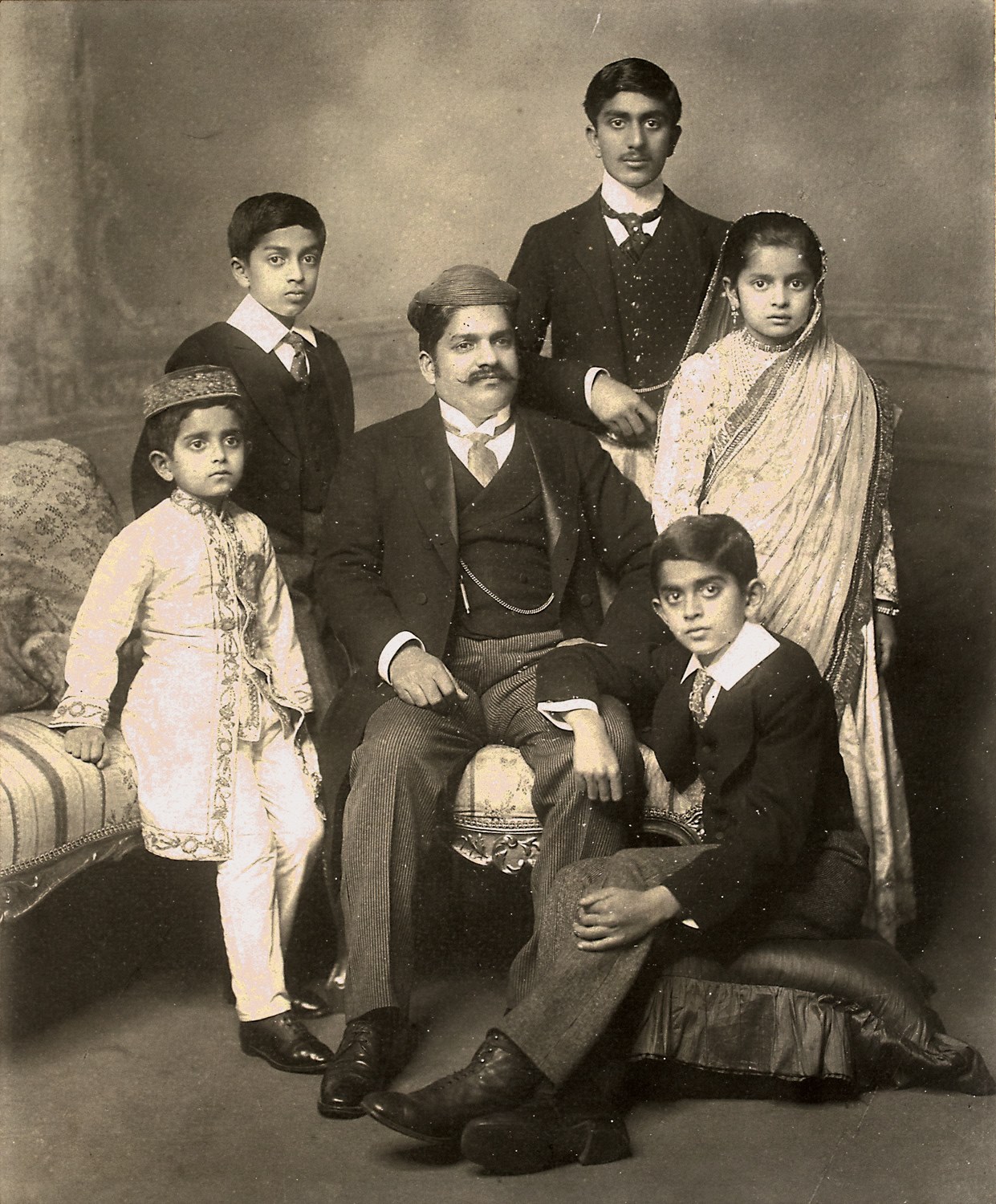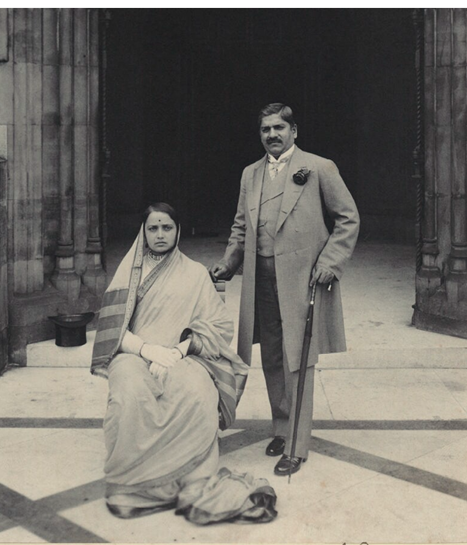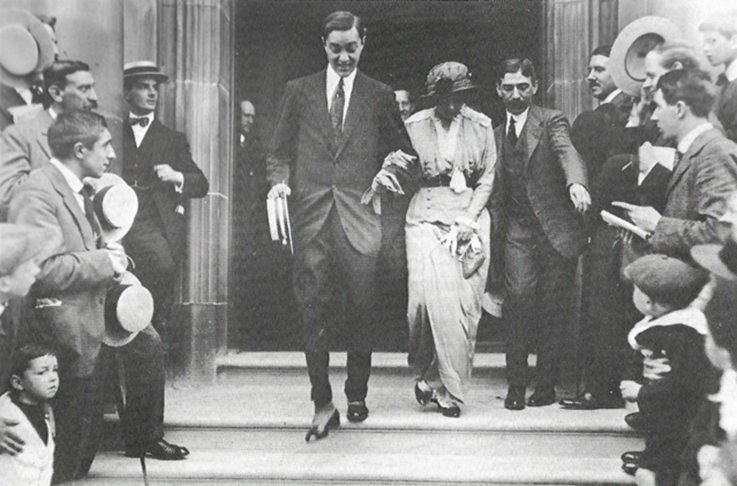On 25 August 1913, a young couple left Paddington registry office in London after a short civil wedding ceremony. The bride was the daughter of the second most powerful ruler in India and her groom was the brother of a lowly Indian prince. Her upbringing, engagement, and life broke with every tradition of British India, angered half its princes… and created one of India’s greatest female icons.

Background
It is a period of Indian history known as the British Raj. Britain directly rules over two-thirds of the Indian subcontinent; the remaining two-fifths is divided into around 600 Native States, ruled over by native princes who swear loyalty to the British Crown.
Princess Indira Raje was born in 1892 in the princely state of Baroda in present-day Gujarat. She was the only daughter of Sayajirao III, the Maharaja Gaekwad of Baroda, and the second most powerful prince in India, ruling over 8,000 square miles with an annual income of 13.5 million rupees.
Indira grew up with her brothers in the unimaginable splendour of the Lakshmi Vilas Palace. Due to her parents’ progressive views on education, she was the first Indian princess to attend school and college. Like Jitendra, she too grew up visiting England and Europe for the ‘season’ with her father, who was very popular and influential in England, and her mother, who sponsored many British charities, going to dances, balls, receptions and garden parties with English royalty and aristocracy. As she grew up, Indira became renowned in both India and Britain for her extraordinary beauty, sharp wit, and fine intellect.

An Unfortunate Betrothal
Indira’s defining good looks were soon noticed by several Indian princes. First among them was Madho Rao Scindia, the Maharaja of Gwalior. Gwalior, like Baroda, was one of the richest, largest, and most powerful of the Indian Native States; additionally, like the Gaekwads, the Scindias were an ancient and noble Maratha house. So, naturally, his and Indira’s would be the ideal marital alliance.
Unfortunately for Indira, her suitor was some twenty years older than her, already married, and wanted little more than someone to give him a male heir. However, Indira’s feelings had nothing to do with it and the noble and powerful suitor was too good for her parents to turn down. Accordingly, in 1910, with Indira aged just 18, her engagement to the Maharaja was announced.

Love at First Sight
A year after Indira’s betrothal, in December 1911, all of India’s royalty and nobility gathered in India’s new capital, Delhi, for the Delhi Durbar. The Durbar was to crown King George V as Emperor of India, the only British monarch to travel to India to do so. The crowning occasion was when all the rulers of India paid homage to the emperor in a great ceremony on a specially made parade ground to thousands of onlookers. In fact, Indira’s father caused quite a commotion when he failed to bow correctly when his turn came.
It was here where Indira met Prince Jitendra Narayan for the first time.
Prince Jitendra Narayan was born in 1886, the second son of Maharaja Nripendra Narayan and Maharani Suniti Devi of the princely state of Cooch Behar in West Bengal. Like most Indian royalty, he received his education in England; he attended Eton College and then Cambridge University. In 1911, his father (who, alongside his wife, was very popular and well-known to the British) died in Bexhill-on-Sea and was succeeded by Jitendra’s older brother, Rajendra.
Little is known about how they met or how they spent the festivities together, but one this is for certain, it was love at first sight. By the time the Durbar was being dismantled and the great royal families were returning to their states, Indira had made up her mind; she was in love with Jitendra and would marry no other.
But in princely India, an engagement was as good as marriage itself and so Indira had little hope of her parents breaking off her engagement to Gwalior because she had found someone else. So, in an incredibly brave and unprecedented move, the eighteen-year-old princess wrote to her fiancé herself, saying she would not marry him. Her parents only heard of this when, with wedding preparations almost complete, the Maharaja Gaekwad received a telegram from Gwalior with the single sentence:
‘What does the princess mean by her letter?’
No doubt Indira was hauled before her parents and given a lecture on family honour and the scandal this would bring. But the damage was already done and there was no question of her marrying the Maharaja now. Besides, Madho Rao made no fuss, writing an understanding letter to the Maharaja Gaekwad and finding another wife elsewhere.
Gaining Parental Permission
Indira’s problem now was convincing her parents to let her marry Prince Jitendra. A great many problems laid in her and Jitendra’s way.
First was religion and race. The Gaekwad and his family were of Maratha descent and strict orthodox Hindus; the Cooch Behar’s, however, practiced Brahmo Samaj, a monotheistic version of Hinduism and were Bengali. Second was the problem of precedence and prestige. The princes of India and their states were strictly hierarchised by the British according to their wealth, size, history, and importance. The Gaekwads of Baroda were the second most prestigious princes in India; the Maharajas of Cooch Behar, however, were placed forty-sixth, an enormous come-down for Indira.

Foremost, however, was that Indira’s father viewed Jitendra as a drunken playboy (not entirely incorrect) who had no hope of succeeding to the throne, and viewed his family in general as too westernised and debauched (alcoholism, crime, and bankruptcy amongst members was rampant).
Regardless, Jitendra and Indira continued to meet in private over the next two years. The Maharaja Gaekwad even summoned Jitendra to Baroda to command him to have no delusions of ever marrying his daughter. But he must also have realised that to further deny the marriage may cause Indira to elope and cause even greater scandal. Accordingly, in the spring of 1913, Indira’s parents finally surrendered, and the betrothal of Princess Indira and Prince Jitendra was announced.
The Runaway Bride
However, on 5 May 1913, just two days before it was due to take place in Kolkata, Indira’s wedding was called off. It was later discovered that her father had changed his mind and that he would ‘never consent to the match’. He and his daughter instead left for London. But Indira had no intention of giving up so close. When asked by a reporter after arriving in London, she outright declared:
“I have been engaged to Prince Jitendra for a long time and have always wanted to marry him…but at the last minute my parents refused to sanction my marriage”.
Indira had now essentially thrown her father into a corner. Her refusal of the Maharaja of Gwalior had removed any possibility of marrying a premier prince, her and Jitendra’s love story was known across the globe, and this comment had officially rendered her father the villain of the fairy tale.
Therefore, whilst on a family holiday in St. Moritz in Switzerland the following August, the Maharaja Gaekwad gave his consent for Indira to travel to London and quietly marry Jitendra. She would, however, travel alone and not a single member of her family would be present on her wedding day.
Indira clearly did not mind, for two days later she arrived at London’s Waterloo Station. The Daily Mail described her as looking ‘as happy as a schoolgirl’, wearing ‘a close-fitting costume of blue with a large white Peter Pan collar’.
‘Self-possessed and smiling, this pretty girl made her way along the crowded platform to a taxicab, attracting attention on account of her beauty’
The Wedding Day
‘The sun was shining with a brilliance almost worthy of an Indian Summer…’
This was how the Daily Mail began its coverage of the wedding of Prince Jitendra and Princess Indira on 25 August 1913. The day was split into three ceremonies.
The first took place that morning in the Buckingham Palace Hotel, where Indira converted and was received into the Brahmo Samaj by her soon-to-be mother-in-law, the Maharani Suniti.

Then came the civil wedding service at Paddington Registry Office. 300 well-wishers, who had no doubt been following events in the tabloids, stood outside as Jitendra arrived in a dark lounge suit and straw hat. He was soon followed by Indira in a ‘sumptuously appointed motorcar’ and wearing ‘a fashionable Rose du Barry moire dress with a deep collar of white lace’. Dozens of photographers were waiting outside as the bride and groom left the ceremony whilst ‘one poorly dressed woman, with a baby in her arms, threw confetti at them.’

The final ceremony was the Brahmo wedding service back at the Buckingham Palace Hotel. Indira changed into a pink and gold sari, whilst Jitendra sported his best white robes and turban. The reception after was well attended and the wedding cake was cut with the State Sword of Cooch Behar Jitendra’s brother had lent them.
Congratulations flowed in from across India, Europe, and Britain, including from the King and Queen themselves. Indira and Jitendra’s official wedding photograph even made the front page of the Daily Mirror a few days later. But, most importantly, after all they had been through to get there, the Daily Mail made sure to highlight that:
‘The bride and bridegroom looked extremely happy’
Later Life
Jitendra and Indira spent their honeymoon in Maidenhead, Berkshire. But, as in all great romances, the honeymoon bliss did not last long…
Only three weeks after the wedding, Jitendra’s brother, Maharaja Rajendra, died of alcoholism in Cromer on England’s west coast. Jitendra and Indira were now Maharaja and Maharani of Cooch Behar and rulers of several million people, and immediately took on all of Rajendra’s duties.
Maharani Indira soon made peace with her parents, perhaps by virtue of her new title, and was soon seen hunting and attending parties with her father. Jitendra, alongside many other Indian princes, travelled with the Indian Expeditionary Force to France at the beginning of the First World War in 1914 and was knighted after the armistice. They had five children: Prince Jagaddipendra, Princess Menaka, Prince Indrajitendra, Princess Ila, and Princess Gayatri.
They were married for nine years, but the curse of alcoholism struck the royal house of Cooch Behar once again and Jitendra died in 1922, aged just 36. Indira was now a widow aged just 30. She was made regent for her seven-year-old son, responsible for ruling over millions of people; but it was a role she excelled in and conducted for nearly fifteen years.
Never one to keep with tradition, Indira also refused to confine herself as royal widows usually did. Instead, she continued to dazzle Europe and India with her definitive style, wit, and beauty. She was widely acknowledged as one of the most beautiful women in the world; she spent a fortune on shoes from Florence and popularised the sari by having hers made with the finest silk in Paris. She remained at the top of European high society, always invited to royal and aristocratic weddings and occasions and perpetually in the tabloid newspapers. Her parties in London, Paris, and India were also legendary. Instead of following the widow’s austere life confined to the house and spent in prayer, she showed that women could entertain without the company of their father or husband.

Indira died in Mumbai in 1968, India’s first educated princess, a maharani, a regent, a mother to a maharaja and three maharanis, a fashion icon, and a trailblazer for Indian culture and women. Maharani Gayatri Devi of Jaipur, who followed on from her mother as one of the most beautiful women in the world remembered her mother as:
“Quite simply the most beautiful and exciting woman any of us had known. She remains in my memory as an unparalleled combination of wit, warmth and exquisite looks.”



















